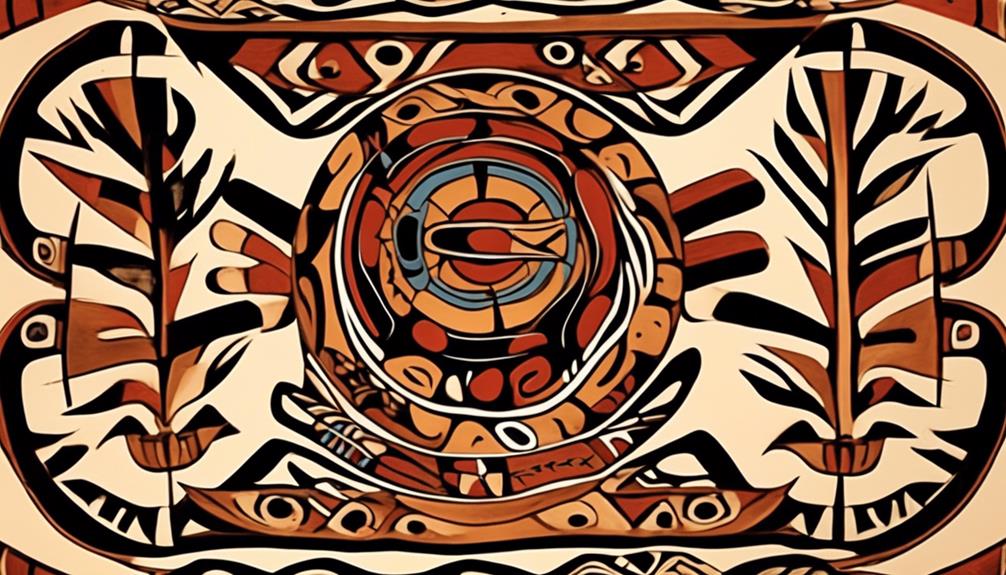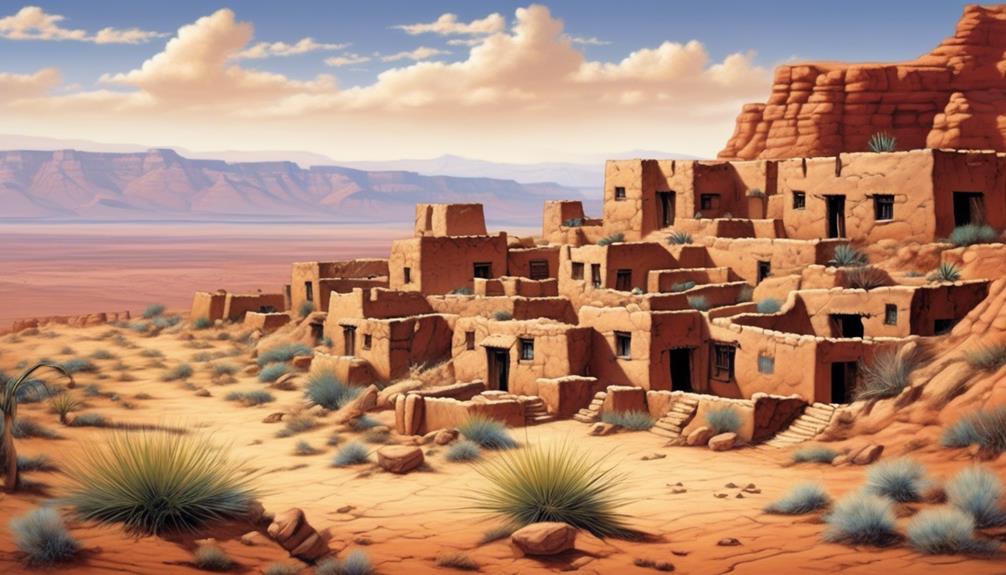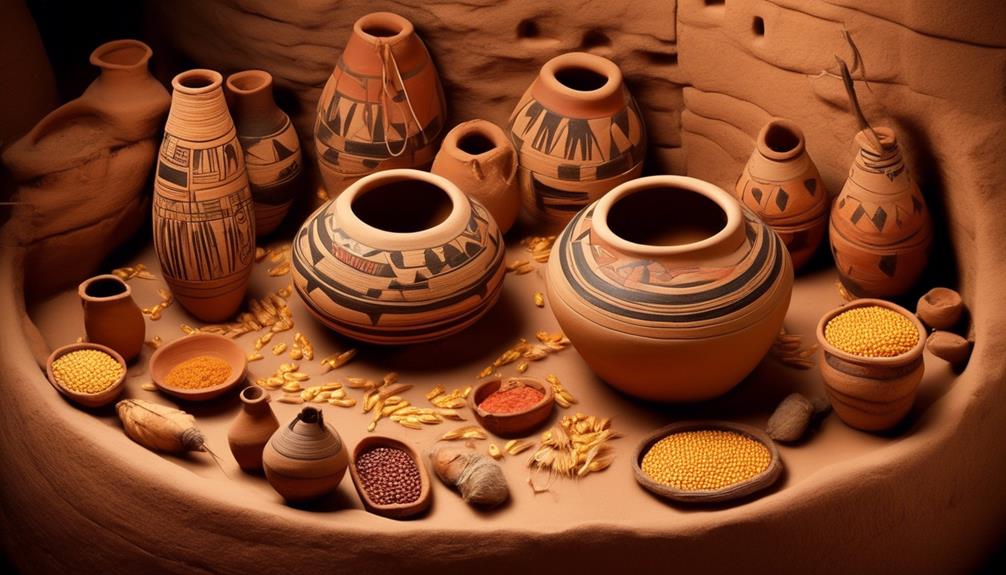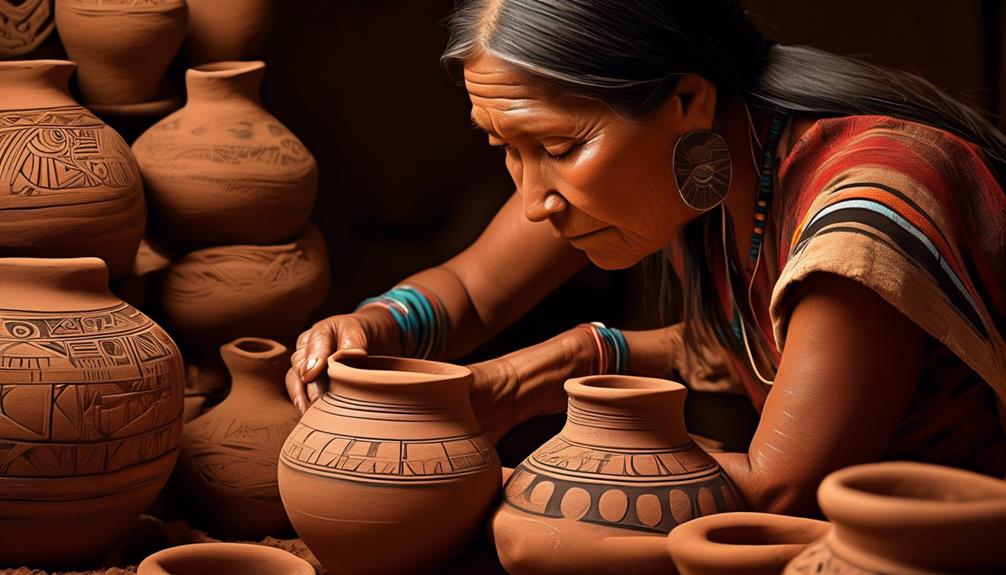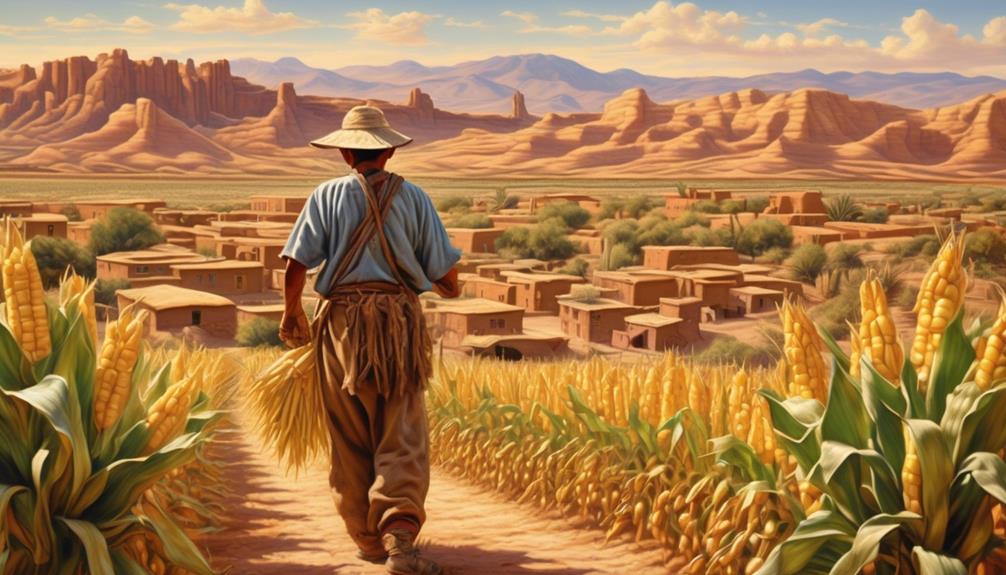We recently came across a stunning piece of Hopi pottery that left us in awe of the intricate designs and skilled craftsmanship. This piqued our interest in the other traditional crafts that the renowned Hopi tribe is known for.
As we delved into this topic, we discovered a rich tradition of Katsina dolls, textile arts, silverwork, and basketry. Each craft holds its own unique story and significance within the Hopi culture.
But what makes these crafts so special to the Hopi people? Stay tuned to uncover the fascinating world of Hopi craftsmanship and the cultural significance behind each art form.
Key Takeaways
- Hopi Pottery and Katsina Dolls are revered art forms passed down through generations, showcasing intricate designs and skillful craftsmanship.
- Textile Arts and Silverwork exhibit exceptional weaving techniques and exquisite craftsmanship, reflecting the weaver's creativity and connection to tradition.
- Basketry involves the coiled basketry technique and incorporates intricate patterns and designs that tell unique stories, symbolizing the interconnectedness of life.
- The crafts, including pottery, dolls, textiles, and basketry, hold cultural significance, preserving the Hopi tribe's cultural heritage through their designs, symbolism, and storytelling elements.
Hopi Pottery
Hopi pottery is a revered art form that has been passed down through generations, showcasing intricate designs and skillful craftsmanship. The firing techniques used by the Hopi people are integral to the creation of their pottery. Traditionally, they employ outdoor firing methods, using sheep dung as fuel to achieve the distinctive coloration of their pottery. This firing process is a meticulous art in itself, requiring precise control of temperature and oxygen levels to produce the desired results. The designs adorning the pottery often hold deep cultural significance, with each symbol and motif telling a story or representing a specific aspect of Hopi life and beliefs.
The cultural significance of Hopi pottery extends beyond its artistic value. It serves as a means of preserving and celebrating Hopi heritage, with each piece reflecting the tribe's traditions and history. While historically used for practical purposes, such as carrying water, contemporary Hopi pottery continues to honor these traditions while also finding a place in the world of art, where it's highly sought after by collectors and enthusiasts alike.
The timeless beauty and cultural richness embodied in Hopi pottery ensure its continued relevance and appreciation in the modern world.
Katsina Dolls
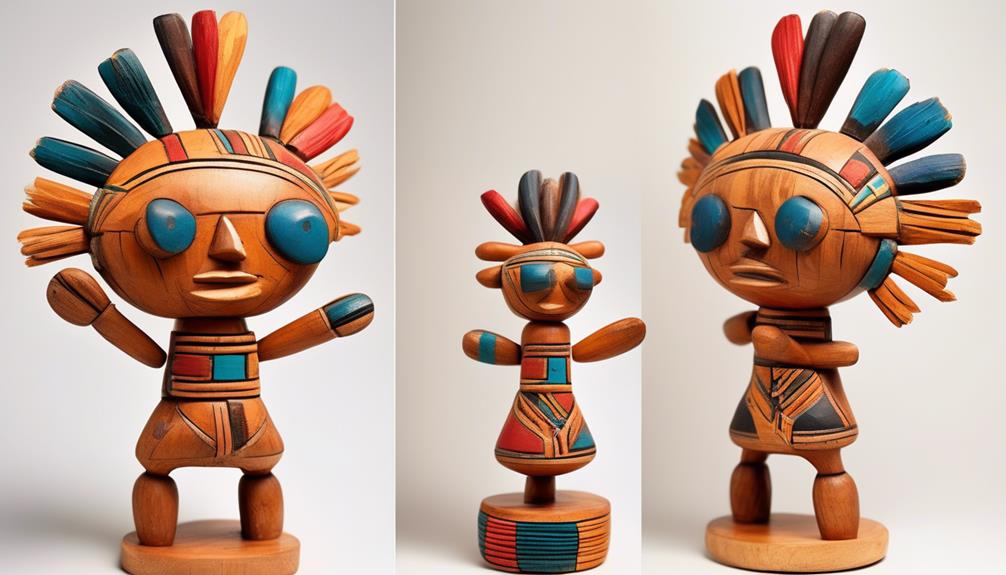
Carved with intricate details and vibrant colors, Katsina dolls are symbolic representations of spiritual beings in Hopi culture. These dolls play a crucial role in religious ceremonies and are often given as educational tools to teach Hopi children about their spiritual beliefs and the traditions of their people.
The symbolism attached to Katsina dolls is profound, with each doll representing a specific deity or ancestral spirit. The dolls are meticulously crafted to embody the essence of these spiritual beings, with their attire, colors, and facial expressions all holding significant meaning within the Hopi belief system.
Traditional katsina carving techniques are closely guarded and passed down through generations within the Hopi community. The process of creating these dolls involves a deep spiritual connection, with carvers often meditating and praying before selecting the cottonwood root from which the doll will be carved. The carvers use simple tools such as knives and sandpaper to meticulously shape and refine the dolls, infusing them with spiritual significance through every step of the carving process.
Each doll is a unique piece of art, reflecting the rich cultural heritage and spiritual depth of the Hopi tribe.
Textile Arts
Crafted with intricate skill and adorned with vibrant hues, the textile arts of the Hopi tribe showcase their rich cultural heritage and artistic prowess. The Hopi people are renowned for their exceptional weaving techniques and the use of natural dyes to create stunning textiles that hold deep cultural significance. The art of weaving is passed down through generations, and each piece reflects the weaver's creativity and connection to tradition.
| Patterns | Materials Used | Significance |
|---|---|---|
| Geometric | Cotton, wool, feathers | Represent spiritual elements and clan symbols |
| Kachina | Yucca, rabbit brush | Depict ceremonial figures and stories |
| Striped | Yucca, sumac, plants | Symbolize rain, growth, and fertility |
The intricate patterns and vibrant colors of Hopi textiles are achieved through the use of natural dyes derived from plants, minerals, and insects, showcasing the tribe's deep understanding of their natural environment. Weaving techniques vary from intricate, small-scale weaves used in ceremonial sashes to larger, coarser weaves for blankets and clothing. The mastery of these techniques allows the Hopi tribe to create textiles that are not only visually striking but also deeply meaningful, preserving their cultural narratives for generations to come.
Silverwork
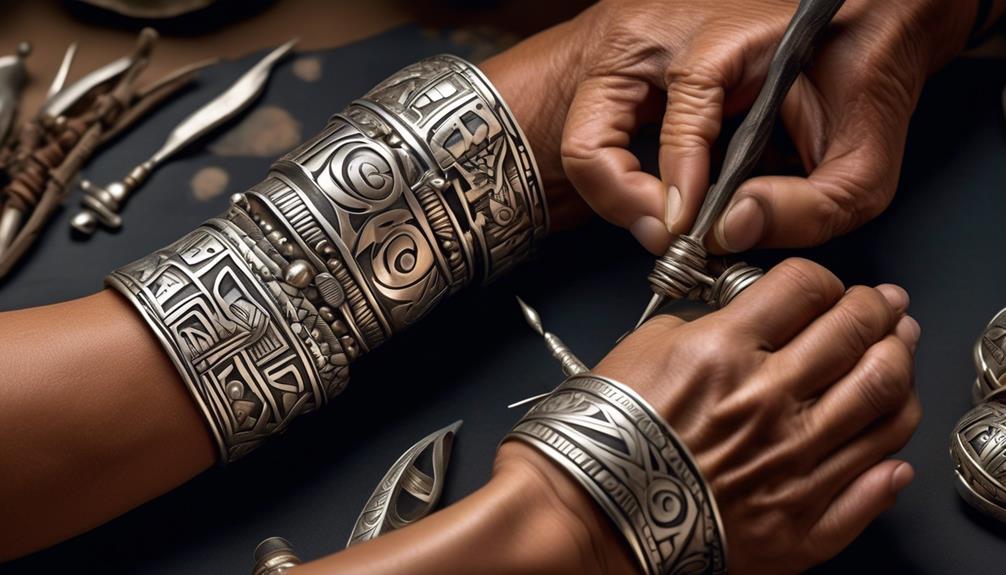
Adorning themselves with exquisite silverwork, the Hopi tribe demonstrates their exceptional craftsmanship and artistic expression, incorporating intricate designs that reflect their cultural symbolism and narratives. The traditional techniques of silverwork have been passed down through generations, with artisans meticulously crafting each piece by hand. The use of traditional methods not only preserves the cultural significance of these creations but also adds a unique artistic expression to each piece.
Despite the traditional nature of Hopi silverwork, modern influences have also made their mark. Contemporary designs and innovative approaches have emerged, reflecting a blend of tradition and modernity. This fusion allows for the continued evolution of silverwork while still honoring its deep-rooted cultural significance.
The art of silverwork holds great importance within the Hopi community, as it serves as a means of storytelling and preserving cultural heritage. Each piece carries with it narratives of the tribe's history, beliefs, and customs, making it a vital aspect of artistic expression for the Hopi people. The intricate designs and craftsmanship of Hopi silverwork truly exemplify the tribe's dedication to preserving tradition while embracing innovation.
Basketry
The intricate artistry and cultural significance found in Hopi silverwork beautifully parallels the craftsmanship and symbolism woven into their exquisite basketry. Hopi basketry techniques are a vital part of our heritage, with each basket telling a unique story through the intricate patterns and designs. The coiled basketry technique, using sumac or rabbit brush, creates sturdy and visually stunning pieces that have been passed down through generations. This traditional craft holds immense cultural significance, often used in ceremonies and rituals, symbolizing the interconnectedness of life.
Preservation efforts:
- Efforts to preserve these ancient techniques are evident through community workshops and cultural programs, ensuring that the knowledge and skills are passed down to future generations.
- Museums and cultural institutions also play a crucial role in preserving and showcasing these masterpieces, recognizing their cultural and historical importance.
Contemporary applications:
- While traditional basketry remains integral to our culture, contemporary artisans are exploring innovative ways to incorporate basketry into modern art forms, ensuring its relevance in today's society.
Frequently Asked Questions
What Are the Traditional Colors and Designs Used in Hopi Pottery?
We use traditional designs, natural pigments, symbolism, and geometric patterns in Hopi pottery.
Our designs often depict animals, plants, and spiritual elements, while our natural pigments come from local minerals and plants.
Symbolism is integral to our pottery, with each design carrying deep cultural and spiritual significance.
Geometric patterns are also prevalent, representing balance and harmony.
Our pottery is a reflection of our heritage and spirituality, embodying centuries of tradition and craftsmanship.
How Are Katsina Dolls Used in Hopi Religious Ceremonies?
Well, Katsina dolls are pivotal in Hopi religious ceremonies, embodying symbolism and tradition. Carved with precision, these dolls serve as messengers of ancestral spirits. During ceremonies, they're gifted to children, imparting cultural knowledge and values.
The intricate carvings and vibrant colors convey stories of the Hopi people. These traditions are deeply rooted in the tribe's spirituality, making the Katsina dolls a significant part of their religious practices.
What Types of Textiles Are Commonly Woven by the Hopi Tribe?
Hopi weaving holds a special place in our tribe's cultural heritage. We meticulously craft textiles with traditional patterns, using natural dye techniques that have been passed down for generations.
Our textile production reflects the deep connection to our land and history, showcasing intricate designs that tell the stories of our people. The vibrant colors and intricate details in our weavings are a testament to the skill and artistry of the Hopi tribe.
Can You Explain the Significance of Silverwork in Hopi Culture?
Hopi jewelry and metalwork play a significant role in our culture. These crafts are a symbol of tradition, spirituality, and connection to the land.
The intricate designs and use of silver reflect our deep reverence for nature and the spiritual world. Hopi artisans skillfully create jewelry and metalwork, incorporating traditional symbols and motifs that embody our heritage and beliefs.
These crafts serve as a way to preserve and pass on our cultural identity.
What Types of Plants Are Traditionally Used in Hopi Basketry?
Weaving techniques, plant materials, and basketry symbolism are essential to traditional Hopi crafts.
The dyeing process adds vibrant colors to the baskets, with designs often symbolizing elements of Hopi culture.
Basketry represents a connection to the earth and the natural world, using materials like rabbitbrush, sumac, and devil's claw.
The intricate process of gathering and preparing these plants reflects the deep significance of craftsmanship in Hopi culture.
Conclusion
In conclusion, the crafts of the Hopi tribe are a testament to their rich cultural heritage and artistic skill. From the intricate designs of their pottery to the intricate details of their Katsina dolls, each craft tells a story of tradition and craftsmanship.
As the saying goes, 'The art of a people is a true reflection of their soul,' and the crafts of the Hopi tribe certainly reflect their deep connection to their culture and history.
Mary is a passionate writer who brings creativity and a fresh perspective to our team. Her words have the power to captivate and inspire, making her an essential contributor to our content. Mary’s commitment to storytelling and dedication to promoting Indigenous culture ensures that her work touches the hearts of our readers. We’re fortunate to have her as part of our team.
